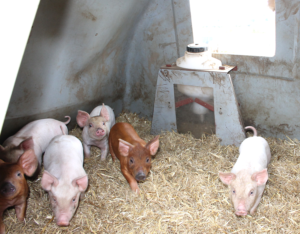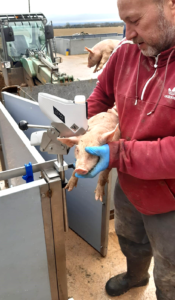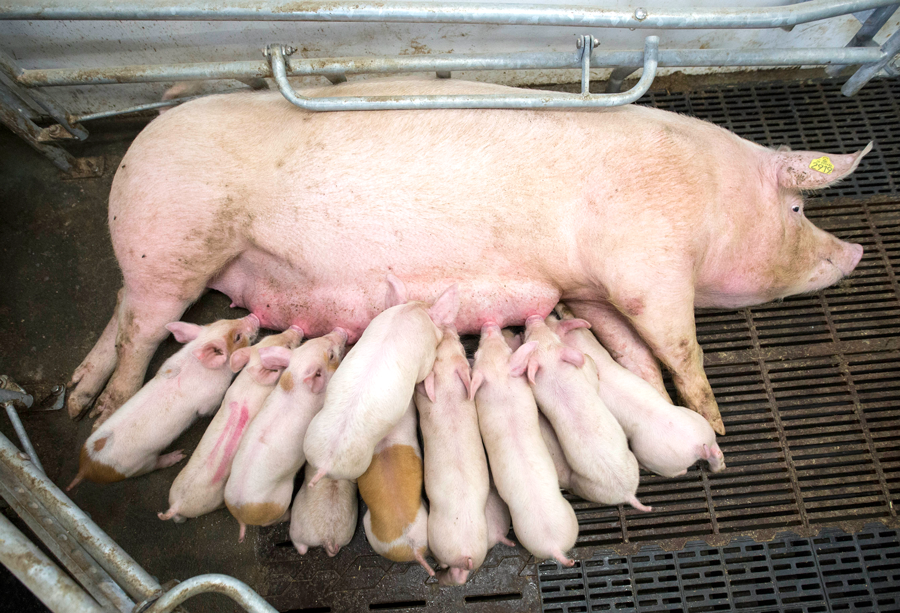Farrowing crates and new innovations: What’s next for the pig sector?
25th May 2021
Jane Jordan explores some of the latest updates for the pig sector, including whether the farrowing crate can survive growing pressure from the welfare lobby; an innovative in-hut creep feeder; and a new intradermal multi-valent vaccine.
Confining sows during farrowing and lactation has always proved a controversial issue; although farrowing crates undeniably improve piglet welfare and survival rates, the commercial success of the UK’s outdoor pig sector has undoubtedly brought the ethics of confining sows under more public scrutiny.
Germany’s decision to phase out the use of farrowing crates within the next 15 years is also likely to increase the pressure for a similar ban here. The National Pig Association is already talking to welfare groups, politicians and Government advisors to ensure Whitehall is well briefed and not bending to propaganda peddled by certain activists. The industry is not opposed to freedom farrowing; it just wants a balanced debate and every opportunity to find viable alternatives to the crate; systems that will enable UK pig farmers to remain competitive while prioritising sow and piglet welfare and the safety of those that take care of them.
CIWF believes crates could be phased out successfully, if the pig industry is given adequate time to develop workable alternatives and learn new skills. It believes a 5- to 8-year transition period is commercially possible and Defra’s ‘public money for public goods’ agenda could potentially offer farmers some financial support to invest in new, unrestrained farrowing accommodation. Its calls for greater collaboration between Government, industry and the supply chain, to ensure any commitment to phase out farrowing crates is given mandatory support from clear labelling and tough legislative measures to protect UK farmers from sub-standard imports.
The RSPCA agrees and wants to see wider discussion on the crate debate and more research on freedom farrowing systems. Kate Parkes, its pig sector manager, says scientific data on these systems is scarce and most commercial evidence is purely anecdotal.
Nevertheless, the RSPCA firmly believes indoor producers could take advantage of the burgeoning ‘high welfare’ pork market. It’s Assured pork scheme (formerly Freedom Food) now accounts for almost a quarter of UK pork production; and demand for its products is rising year-on-year. Currently, very few indoor units can satisfy its free farrowing criteria as no form of crate, temporary or free-access, is permitted and only bedded pens that allow complete freedom before/during birth and throughout the suckling period are allowed.
But the UK’s outdoor pig business is facing key challenges. Suitable land is in short supply and environmental regulations are getting tougher, which could inhibit this brand’s expansion prospects.
Many indoor breeding herds considering investment in farrowing accommodation are building free farrow options into their plans. Some do want a slice of the premium high- welfare market, but most are just keen to ‘future proof’ their businesses against prospective legislation.
Splitting the difference
Essex farmer Fergus Howie began freedom farrowing around seven years ago. His family’s Wicks Manor herd currently farrows 40 per cent of sows in unrestricted pens, while the rest are managed in conventional crates.
The Howies’ business is the largest, family- owned, fully-integrated, field-to-fork pork production operation in the UK. It breeds, finishes, and processes all of the pigs it produces – some 110 a week. It supplies food service outlets, including sports stadia and local authorities (mainly school meals); produces premium standard/regional preferred producer lines for high-end grocery, multiple retailers and has its own farm/online shop. It also supplies high-value export markets in Hong Kong, Taiwan and Singapore.
“Pork quality is paramount, but our high-welfare ethic is a valuable USP and we do require an element of freedom farrowing in our system,” Fergus explains.
The 220-sow breed to finish unit is predominantly straw-based, with all piglets weaned at around four weeks of age then reared to 110kg liveweight. The herd is fed with home- grown cereals, and the business bolsters its own production with Red Tractor British pigs, when demand exceeds supply.
Fergus says the 60 per cent crate, 40 per cent free farrow split is a good balance because litter quality out of the freedom pens is inconsistent. Free farrowing sows perform well with good appetites and high milk yields, but weaning weights are more variable and mortality rates are higher. The injury level is also higher for both sows and piglets in these pens and the man hours needed to keep productivity on track is considerably higher – they’re 200 per cent more labour intensive than conventional crates.
“We get reasonable results from our free farrowing pens. Sows wean about 10 pigs a litter, but this system alone can’t offer the consistency, in terms of numbers weaned or piglet quality, that we need. Our freedom system is necessary, but economically we can only really sustain the higher running costs because our conventional crated system is so much more efficient,” Fergus adds.
What initially began as simple, straw-bedded 2x2m pen with rails has now developed into a more sophisticated system with part solid/part slatted ‘Comfort’ flooring, and bedding for enrichment.
The latest pen design by Quality Equipment still gives the sow 360-degree movement and freedom at all times, but it’s easier to keep clean, less labour intensive and more cost effective.
Feeding the five-week ideal
The challenge to improve weaner quality is encouraging some outdoor herds to increase weaning age to 35 days, but extending lactation means piglets and sows are likely to need additional nutritional support. A number of outdoor sites are exploring creep feeding which, theoretically, is a good idea – it pays dividends on indoor farms – but in practice it can be quite challenging.
Rob McGregor, who manages two outdoor herds in north Norfolk, has been ‘tinkering’ with creep feeding for over a year. He’s developed an in-hut feeder which, with some additional design input from engineering company Contended Products, is now successfully feeding pigs from three weeks of age on his 1,000-sow outdoor unit.

The CFS fits securely and unobtrusively inside the farrowing hut.
Named CFS (creep feed station), the compact unit fits unobtrusively inside the farrowing hut and can hold up to 4.5kg of pelleted feed – around a weeks’ supply. It is mounted securely on the back wall and easily filled up through the rear air vent.
The CFS has a precision, rota-moulded funnel- shaped hopper with a lid with a spiral spring feeder fitted at the outlet. When agitated, the spring scatters creep onto the floor. A strong steel cradle supports the hopper, and a trapezium- shaped steel panel covers one side (top-to- bottom) of the unit. This protects the spring mechanism/hopper and also serves as the front wall of the piglet creep area, which together with the back wall of the farrowing hut, forms a walk- through feeding passage that piglets can access from either end.
Initial farm trials have recorded some excellent results. Feed consumption is higher than expected, waste is minimal and weaning weights have been consistently good – weaned litter weights are in excess of 100kg.
“The CFS design exploits piglets’ inquisitive nature. They play with the spring; the feed drops onto the floor and they quickly root it out and eat it. There are no troughs or bowls to get dirty and creep isn’t left lying around getting stale. And the feed is protected because it’s inside the hut, away from the weather and vermin,” says Mr McGregor.
Piglet feeders are placed in the farrowing huts when pigs reach 20 days of age, 8–10 days before weaning. Rough calculations (total weight of feed used per hut, divided by litter size weaned) show that each piglet is eating about 340g of creep during their final week, which Rob says is comparable with indoor piglets (which consume around 370g during the same period). He estimates average creep intake per piglet per day is 75–85g by weaning – a significant volume considering they are also suckling and rooting around the paddocks for other morsels.
Extensive trials with the CFS are currently underway with a large-scale producer and national feed company.
Needle-free efficiency
The arrival of a new generation, multi-valent vaccine from Hipra offers producers another means of protecting pigs from PCV2 and Mycoplasma hyopneumoniae in a single-dose, needle-free vaccination. Mhyosphere PCV intradermal (ID) offers immunity against these diseases throughout the rearing/finishing stages when given from weaning at four weeks stages. It’s also improved of age.
Lincolnshire farmer convinced me that David Owers introduced it to his weaning routine in November 2020, initially as a trial batch with 600 pigs to see how it performed against his existing vaccine programme. The results were impressive and the business now vaccinates all of its piglets with Mhyosphere.
Unit staff say they didn’t see any marked difference in health status – PCV2 and pneumonia remained under control. But they did notice a change in piglet behaviour. The trial batch of weaners were much more alert in the 48-hours post-weaning; they weren’t lethargic and were more eager to eat and drink. They also reached 40kg almost a week earlier.

Stockman Ian Palmer vaccinating the latest batch of weaners using the new Hipradermic 3.0.
Although the previously used single- dose PCV2/Mhyo vaccine was effective and minimised handling – weaners were only picked up once – the physicality of the injection was still quite brutal compared with ID treatment. Stockmen also felt dosing accuracy was better as they didn’t have to hold the vaccinator and the piglet at the same time. The Hipradermic device can be mounted on the pen and piglets are lifter up to it for treatment.
Myhosphere has brought performance benefits, with lower, mortallity overall and better growth in the early stages. It’s also improved the efficiency and safety of the weaning/vaccination process without compromising health or productivity.
Of the 600 pigs vaccinated with Hipra’s dual-action ID vaccine, only three deaths were recorded from weaning to slaughter (0.5 per cent mortality) and no in-feed or water medication was used. Farm records show finishing herd mortality usually sits between 1.5–2.2 per cent and only one pig in this batch was treated with antibiotics for lameness.
It wasn’t just performance that persuaded David to use ID vaccination. Earlier this year, two stockmen had to self-isolate and David had to help wean and vaccinate 1,300 piglets. “The whole process proved very challenging and I’d forgotten how barbaric needles could be. It convinced me that needle-free was a far better option,” he explains.
David hadn’t realised how much pressure mass vaccination placed on his staff; how frustrating bent/damaged needles could be and how much more waste was generated. “This clinical waste requires specialist disposal, which also comes at a cost. Mhyosphere is packed in 250, 125 and 50 dose vials and we only used four small bottles to vaccinate the 600 pigs in our trial – and no needles. For a pig business like ours, that represents some significant savings,” he concludes.

